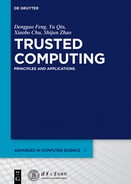0%
23Chapters
0-1Hours read
0kTotal Words
Table of Contents
- Cover
- Title Page
- Copyright
- Contents
- 1 Introduction
- 2 Trusted Platform Module
- 3 Building Chain of Trust
- 4 Trusted Software Stack
- 5 Trusted Computing Platform
- 6 Test and Evaluation of Trusted Computing
- 7 Remote Attestation
- 8 Trust Network Connection
- Appendix A: Foundations of Cryptography
- References
- Index
